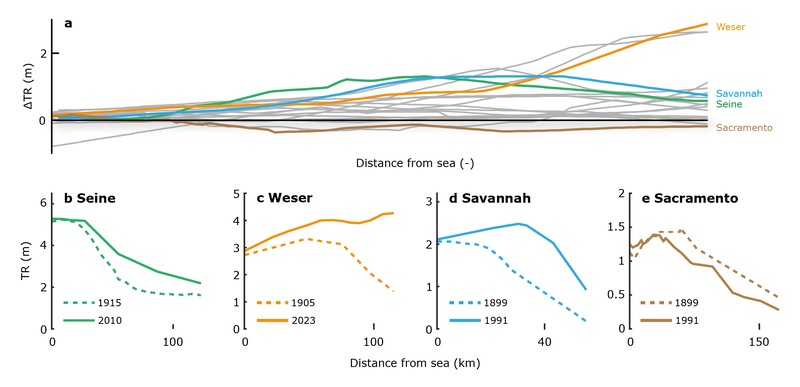J.G.W. Beemster1*, S.A. Talke2, B. van Maren3,4,5 and A.J.F. Hoitink1
1 Hydrology and Environmental Hydraulics Group, Wageningen University and Research, Wageningen, The Netherlands; 2 Department of Civil and Environmental Engineering, California Polytechnic State University, San Luis Obispo, CA, USA; 3 State Key Lab of Estuarine and Coastal Research, East China Normal University, Shanghai, China; 4 Faculty of Civil Engineering and Geosciences, Delft University and Technology, Delft, The Netherlands; 5 Deltares, Marine and Coastal Systems Unit, Boussinesqweg 1, Delft, The Netherlands
* Corresponding author: joris.beemster@wur.nl
Introduction
Estuaries and tidal rivers represent critical coastal ecosystems, profoundly influenced by human activities over centuries. Anthropogenic interventions such as land reclamation and channel deepening have transformed these environments, altering estuarine hydrodynamics and water level patterns. Understanding the complex interplay between human alterations and natural tidal dynamics is essential for assessing the resilience of coastal regions in the face of rising sea levels and changing climatic conditions. This study investigates the impact of human interventions on tidal hydrodynamics in 18 estuaries scattered around the globe. By recovering, digitizing, collecting and examining historical data of estuarine geometry and tidal patterns, we unravel centennial-scale changes of estuarine tidal dynamics and discuss the extent to which human activities have influenced tidal amplitudes, water level extremes, and the spatial distribution of this influence.
Objective and Methods
The objective of this study is to aevaluate the effects of human interventions on tidal hydrodynamics in 18 estuaries around the world. We conducted a comprehensive analysis of historical data spanning multiple decades to centuries, focusing on estuarine geometry, tidal amplitudes, and water level extremes. Our methodology involved collating and analyzing long-term hydrodynamic and geometric data from each estuary. Next, we determined characteristic geometric (e.g. average channel depth, intertidal area) and hydrodynamic (e.g. max tidal range, mean annual discharge) variables over time to understand how changes in geometry affect hydrodynamic behavior. By integrating historical insights with contemporary data, we aim to understand the complex dynamics governing the interaction between human activities and natural tidal processes.
Results
Preliminary analysis reveals significant alterations in tidal hydrodynamics across the 18 estuaries studied. Human interventions, particularly channel deepening, land reclamation and barrier construction, have led to widespread changes in tidal amplitudes and water levels. Our results indicate a general trend of tidal amplification, with the most pronounced effects observed in the landward reaches of estuaries, generally exceeding rates of sea level rise. The spatial distribution of tidal effects suggests a complex interplay between estuarine geometry and human alterations, with narrow funnel-shaped estuaries exhibiting heightened sensitivity to anthropogenic interventions. These findings underscore the pervasive influence of human activities on estuarine hydrodynamics and highlight the need for adaptive estuarine management strategies in the face of changing environmental conditions.

Changes of the tidal range in the eighteen estuaries. a. Along channel changes of the tidal range for the 18 estuaries included in our study, the distance to the sea is normalized by the distance to the most landward observation, along channel profiles of the tidal range in b. the Seine in 1915 and 2010, c. the Weser in 1905 and 2023, d. the Savannah in 1899 and 1992, and e. the Sacramento in 1899 and 1992.


